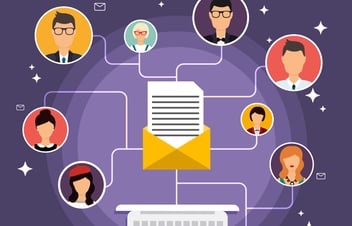The On-Target! 2024 Playbook: Mastering Engagement in a Cluttered Digital World
Mastering engagement requires a deep understanding of evolving trends, advanced technologies, and innovative strategies. As the digital world continues to expand, transform, and become increasingly cluttered, businesses must adapt and refine their approaches to engage, convert, and retain prospects effectively. This playbook provides a comprehensive guide to mastering engagement in the digital age. It is born from decades of experience and acute awareness of the evolving tools and tactics available to overcome these challenges.
1. Understanding the Digital Landscape: It's a whole new world.
How many appeals for your attention do you get every day? Robo-calls, emails, texts, annoying wastes of your time that even strong filtering tools can't completely stop. If you're a legitimate business development rep for a viable provider, this deluge of nonsense is now your greatest barrier to gaining the attention you need from prospects.
As digital transformation reshapes the B2B & B2C landscape, it creates new opportunities and inevitable challenges. Businesses now operate in a hyper-connected environment where information flows rapidly, and decision-making processes are more complex. Key factors shaping the digital landscape include:
- Increased Connectivity: With the proliferation of IoT devices and high-speed internet, businesses are more connected than ever, enabling seamless communication and collaboration.
- Data-Driven Decision Making: The abundance of data allows companies to make informed decisions, but it also requires sophisticated analytics to derive actionable insights. This is where the greatest opportunity to leverage AI to gain insights into data sets that seem too big to handle for many companies.
- Customer-Centric Approach: B2B customers expect personalized experiences, mirroring the B2C sector's shift towards customer-centricity. Your first-party data holds unearthed secrets into gaining and keeping your prospect's and client's interests and loyalty. But, you have to invest time, attention, and resources into gaining these insights.
2. Leveraging Advanced Technologies: Must-use tools
To stay ahead in 2024 and beyond, companies must leverage advanced technologies to enhance engagement.
Key technologies include:
- Artificial Intelligence (AI): AI-powered tools can automate routine tasks, analyze vast datasets, and provide personalized recommendations. If you do not have an AI strategy, then you are putting your company at risk. Intuitive assumptions alone will not provide the type of relevance that B2B & B2C customers expect. They want you to "get them" and provide help, not more clutter. AI chatbots, for example, can engage prospects in real-time, answering queries and providing relevant information.
- Machine Learning (ML): ML algorithms can identify patterns and trends in customer behavior, allowing businesses to tailor their engagement strategies based on predictive insights.
- Customer Relationship Management (CRM) Systems: Modern CRMs integrate AI and ML capabilities to provide a 360-degree view of prospects, enabling personalized engagement and efficient lead management. That said, it takes your insights to provide these tools the necessary guidelines for deeper analysis. Yes, staging a CRM is work. Driving utilization is challenging. But, in 2024 and beyond, it is compulsory to deliver the customer experience that prospects and customers expect.
- Marketing Automation: Automation platforms streamline marketing campaigns, nurturing leads through personalized email sequences, social media interactions, and targeted content delivery. Modern automation tools leverage AI & ML to exponentially improve how you engage, serve, and deliver a good customer experience. What was once measured in days is now measured in nano-seconds. Consider how long you expect a response when you forget your password. How long before a reply comes when you fill-out a form on a provider's website. Today, an auto-responder email saying, "We received your request, and someone will get back to you in 24-48 hours," doesn't cut it.
Asher Strategies 2024 Lead Conversion Study:
When following up in less < 5 minutes from lead inquiry- Conversion rates are 8x higher
- Only 37% of companies follow up within an hour
3. Creating Compelling Content
Content remains king in the digital world. However, the type and quality of content are crucial for effective B2B engagement. Above all else is RELEVANCE! This is the key to standing out from all the clutter.
Strategies for creating compelling content include:
- Thought Leadership: Establish your brand as an industry leader by producing insightful whitepapers, research reports, and opinion pieces on relevant topics.
- Interactive Content: Use interactive content such as webinars, virtual events, quizzes, and surveys to engage prospects actively.
- Personalization: Leverage data to create personalized content that addresses the specific needs and pain points of your prospects.
- Video Content: Video is increasingly popular and effective. Use video to showcase customer testimonials, product demos, and expert interviews.
4. Optimizing Multi-Channel Engagement
Engaging prospects requires a multi-channel approach, ensuring consistent and cohesive interactions across various platforms. Key channels include:
- Email Marketing: Despite the rise of new channels, email remains a powerful tool for engagement. Personalize your emails based on prospect behavior and preferences.
- Social Media: For B2B companies, LinkedIn, Twitter, and industry-specific forums are essential for building relationships and engaging with prospects. Share valuable content, participate in discussions, and leverage social media advertising. For B2C, social media is frequently the #1 channel to their markets. In both cases, these channels are extremely cluttered and challenging. Crafting your unique message and leveraging automation tools is a requirement, not an option.
- Content Marketing: Maintain an active blog and resource center on your website. Use SEO strategies to ensure your content ranks high in search engine results.
- Webinars and Virtual Events: Host informative webinars and virtual events to showcase your expertise, interact with prospects, and generate leads.
5. Emphasizing Personalization and Customer Experience
In 2024 and beyond, using personalization to improve your customer experience is paramount. Prospects and customers expect tailored interactions that address their unique needs. Strategies for enhancing personalization and customer experience include:
- Segmented Marketing: Divide your audience into segments based on criteria such as industry, company size, and behavior. Tailor your marketing messages to the unique pains, interests, and desires of each segment. Unlock these insights using the AI & ML tools discussed above to unlock real relevance.
- Buyer Journey Mapping: Create detailed customer journey maps to understand the touchpoints and interactions that prospects have with your brand. Use this information to optimize the customer experience.
- Feedback and Continuous Improvement: Collect feedback from prospects and customers to identify areas for improvement. Use this feedback to refine your engagement strategies continually.
6. Building Trust and Credibility
Trust is a critical factor in any relationship. It is the hardest thing to achieve in today's cluttered digital world. Building trust and credibility requires a consistent and transparent approach.
Key strategies include:
- Case Studies and Testimonials: Showcase successful projects and satisfied clients through detailed case studies and testimonials.
- Industry Certifications and Awards: Highlight any industry certifications, awards, and recognitions your company has received.
- Transparent Communication: Be transparent about your processes, pricing, and policies. Address any concerns or questions promptly and honestly.
7. Measuring Success and ROI
To ensure the effectiveness of your engagement strategies, it is essential to measure success and ROI.
Key metrics to track include:
- Lead Conversion Rate: Measure the percentage of leads that convert into customers.
- Customer Acquisition Cost (CAC): Calculate the cost of acquiring a new customer to evaluate the efficiency of your marketing efforts.
- Customer Lifetime Value (CLV): Often the most overlooked metric, but most important. This is a must-do if you want to maximize your success. Estimate the total revenue a customer will generate over their lifetime with your company. Look at the top 20% of your customers that likely deliver 80% of your profitability, and calculate their spending since their first order. This group's CLV is what you should build your strategy around.
- Engagement Metrics: Track metrics such as email open rates, click-through rates, social media interactions, and website traffic to gauge engagement levels.
8. Future-Proofing Your Strategy
The digital landscape is continually evolving. To future-proof your engagement strategy, consider the following:
- Continuous Learning: Stay updated with the latest trends, technologies, and best practices in marketing, sales, and engagement.
- Agility and Adaptability: Be prepared to adapt your strategies based on changing market conditions and customer expectations.
- Innovation: Encourage a culture of innovation within your organization, exploring new ideas and approaches to engage prospects effectively.
Conclusion
Mastering engagement in today's environment requires a strategic and multifaceted approach. By understanding the digital landscape, leveraging advanced technologies, creating compelling content, optimizing multi-channel engagement, emphasizing personalization, building trust, measuring success, and future-proofing your strategy, businesses can effectively engage and convert prospects while improving their overall customer experience in 2024 and beyond. This will increase the CLV and the valuation of your company as a result. The future of engagement is digital, and those who embrace and adapt to this reality will thrive in the competitive marketplace.


